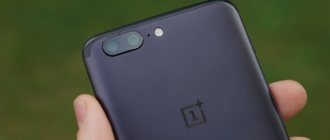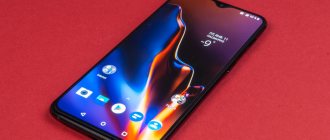I bring to your attention a detailed review of the flagship smartphone OnePlus 5T. Brief characteristics: 6″ Amoled 18:9 / Snapdragon 835 / 6GB / 64GB / 3300 mAh / dual camera / ultra-fast operation and charging. I’ll tell you about all this and much more under the cut. Attention! What follows is a lot of text, photos and screenshots without spoilers. The phone arrived from the Fasttech store by Singapore Post in 3 weeks. 50% of the cost was paid.
Proof
Specifications
Main characteristics:
- Shell: OxygenOS
- Housing material: Anodized aluminum
- SIM card type: Nano
- Number of SIM cards: 2
- SIM card operating mode: Alternating (1 radio module)
- Dimensions (HxWxD, mm): 156.1*75*7.3
- Weight: 162 grams
Screen:
- Screen type: AMOLED
- Diagonal: 6.01″
- Screen resolution: 1080 x 2160
- Pixels per inch: 401
- Gorilla Glass: 2.5D Corning® Gorilla® Glass 5
Memory:
- Built-in memory: 64 GB
- RAM: 6GB LPDDR4X
- MicroSD memory card support: no
Platform:
- OS: 7.1.1 Nougat (Already 8.0)
- Processor: Qualcomm Snapdragon 835
- Graphics accelerator: Adreno 540
- Number of Cores: (4×2.45 GHz Kryo & 4×1.9 GHz Kryo)
- Type: 64-bit
- Those. process: 10 nm
Camera:
- Main camera: dual (16 MP Sony IMX 398 RGB + 20 MP IMX 376K), f/1.7
- Autofocus: Yes
- Flash: dual LED
- Video recording (main): UHD 30 fps / FHD 60 fps / FHD 30 fps / HD 30 fps / HD 120 fps
- Front camera: IMX 371, 16 MP, f/2.0
- Video recording (front): FHD 30 fps / HD 30 fps
Wireless network:
- GSM: 850/900/1800/1900 MHz
- FDD LTE: Band 1/2/3/4/5/7/8/12/17/18/19/20/25/26/28/29/30/66
- TDD-LTE: Band 34/38/39/40/41
- TD-SCDMA: Band 34/39
- UMTS(WCDMA): Band 1/2/4/5/8
- CDMA: BC0
- Wi-Fi: MIMO 2*2, WiFi 802.11 a/b/g/n/ac, 2.4/5 GHz
- Bluetooth: Bluetooth 5.0, support aptX & aptX HD
- NFC: Yes
- Wireless charging: No
Multimedia:
- Supported video formats: MKV, MOV, MP4, H.265(HEVC), AVI, WMV, TS, 3GP, FLV, WEBM
- Supported audio formats: MP3, AAC, AAC+, WMA, AMR-NB, AMR-WB, WAV, FLAC, APE, OGG, MID, M4A, IMY
- Supported image formats: JPEG, PNG, BMP, GIF, DNG
Location:
- GPS, GLONASS, BeiDou, Galileo
Nutrition:
- Battery capacity: 3,300 mAh, Dash Charge (5V 4A)
- Battery mount: Non-removable
Miscellaneous:
- USB Type C (v2.0, OTG, USB Audio support)
Available in three colors. The start of sales of the white version with a rough back cover is scheduled for January 9. In red color it is intended for the Chinese market, however, the fast market already has a 128GB version on sale, but not at a reasonable price. Perhaps there is something cheaper somewhere.
A limited edition was also released, dedicated to the new part of Star Wars.
There are two versions of this smartphone:
- 6 GB RAM and 64 GB ROM (reviewed model)
- 8 GB RAM and 128 GB ROM
Package
Supplied in an ascetic white box made of thick cardboard. Judging by its condition, something like this happened to my parcel.
There's nothing interesting on the reverse side. The interior of the packaging, as always with OnePlus, is thought out to the smallest detail. The smartphone is snapped into a plastic backing to avoid unnecessary shaking.
The package includes: the phone itself, a protective case, a proprietary charger with support for Dash Charge, a USB to Type C cable, a paper clip and waste paper. Instead of an adapter for the usual sockets, the store supplies a third-party charger with a Euro plug. But in this case it is a little more than useless.
The case is silicone and does not represent anything interesting. The same as all the others like it on Ali for a couple of bucks. It doesn’t particularly increase the dimensions, but it can contribute to the appearance of scratches on the lid from debris clogging under it due to a loose fit to the body.
Appearance
I previously used mainly shovels with 5.5″-5.7″ screens, including OnePlus One, but for about half a year I’ve been using the SGS7 with a 5.1″ diagonal. I admit, there were some doubts and concerns about such an impressive size of the 5T. However, in reality it turned out to be not so scary. It literally took one evening to get used to it and shoveling no longer causes discomfort. Those who have not previously owned smartphones with displays >= 5.5″ will probably find this device much more difficult to master. The body is made of anodized aluminum. On specialized forums you can find disputes about the slipperiness of the subject. Some vehemently claim that it fits in the hand like a glove, while others cannot use it without a case. I belong to the second category. For me, almost all metal smartphones are incredibly slippery. 5T was no exception. Like foamed soap, of course, it doesn’t fly out of your hands, but the desired reliable grip on your hand doesn’t occur. There are no complaints about the quality of workmanship and fit of parts. The assembly is not inferior to competitors from A-brands. There is no moisture protection. The 5T is only 2mm taller than its predecessor 1+5 and 3.4mm taller than the 1+3T.
But this is the picture that emerges when compared with competitors that have a screen with an aspect ratio of 18:9. The LG V30 with a similar diagonal has noticeably more modest dimensions, but the price tag is $350-400 higher.
And finally, a comparison with the iPhone 7 Plus and 8 Plus.
Let's move on to considering the design of the subject. 80.43% of the front panel is occupied by a 6.01″ display, on which a quite good protective film is glued out of the box. I’ll tell you why I didn’t take it off a little later. Navigation buttons are now on-screen. This will scare off many, but the time has come when you have to reconsider your priorities. I don’t think that with current trends any manufacturer will return to 16:9 and mechanical/touch buttons.
At the top there are: an LED indicator, a front camera, a proximity sensor, a light sensor and an earpiece grille.
Backside.
On top there is a decently protruding double photo module covered with sapphire glass, an additional microphone and a dual LED flash. The NFC module is hidden behind a thin strip above the camera.
The fingerprint scanner is now on the back. The location is quite convenient. The index finger rests exactly on it. And under the scanner the manufacturer’s logo is engraved. Fortunately, there are no certificates, “made in rank” or other information on the lid. At the top end there were no vital elements.
On the bottom there is a 3.5 mm mini jack, a microphone, a USB Type C 2.0 port and an external speaker. When, so to speak, the phone is tightly compressed in a horizontal orientation, there is a 99% probability that the speaker will be blocked by your hand. It would be more logical to place it on the other side. Well, or turn the phone over so that the speaker is located on top, near your left hand.
On the left side there is a volume rocker and a mechanical sound mode switch.
The lever has a rather tight movement. I've been liking it since its first appearance in OnePlus 2. Unfortunately, it's very difficult to switch it deftly while holding the phone with one hand. Especially with a cover. You have to use your second hand. There are 3 positions available, the behavior of which you can customize yourself. The default settings are Silent, Do Not Disturb, and With Sound. The rocker sits confidently and does not wobble. The click is clear. If you press in the middle, both “+” and “-“ are triggered.
On the opposite side is a tray for two Nano SIM cards and a power button.
Yes, only for SIM cards. There is no possibility of memory expansion. For most, this, of course, will be a serious disadvantage, but on the other hand, the price difference between the 64GB and 128GB versions is noticeably lower than that of many other smartphones. Apparently, this was the calculation. The power button wobbles slightly if you intentionally help it.
About the design of Oneplus 5T
One could say that the design of the smartphone has not changed, but the frameless screen is also a significant part of the design. I didn’t like the regular Oneplus 5 with its appearance. I've been watching their smartphones since the very beginning, and I think the first Oneplus was cool and unique. It was different from everything that was on the market, both in appearance and tactility. The second Oneplus was a pure experiment. And in the third iteration of the smartphone, the company could not stand it and began to partially borrow some features from competitors, maybe consciously, maybe not. And there is nothing wrong with this, because everything here is like with musicians - if you often listen to the compositions of other performers, then, even unconsciously, you will repeat them somewhere.
Oneplus 3/3T, although some elements were similar somewhere to HTC, somewhere to Huawei Mate, incorporated into its design not the most shameful features. But in Oneplus 5, in my opinion, something went wrong. Now Oneplus has become, not only is it like everyone else, but borrowing the appearance from different smartphones is not the best: in some places it looks like Xiaomi, in others like the iPhone 7 plus, in others like any other Chinese smartphone. And again I repeat: the bad thing is not that there is an element of borrowing, the bad thing is that not the most successful design solutions are borrowed.
But, it’s worth paying tribute: the appearance, although not the winning feature of the Oneplus 5T smartphone, in terms of ergonomics seemed to me simply wonderful. Where necessary it is rounded, where necessary it is pointed, the thickness is optimal, the grip is as comfortable as possible. The 5T version is saved by a new, almost frameless screen; the smartphone looks great from the front and looks familiar from the back.
Most people will likely put the protective cover that comes with it on it, or buy the original case, which feels like asphalt - very rough and fits perfectly in the hand, making it almost impossible to accidentally drop it. By the way, with this case, the smartphone looks much better than without it, and does not increase the size of the smartphone.
Screen
OnePlus 5T has a 6.01″ Optic Amoled matrix with a resolution of 1080 x 2160, an aspect ratio of 18:9 (2:1) and an area of 93.21 cm². Optic Amoled is the same Suped Amoled that is installed in top Samsung devices, but with some adjustments and optimizations from OnePlus. I won’t throw around big words about framelessness, because... There are frames and they are clear. Let’s leave the title “Frameless Man of the Year” to all the bluebugs, cubots and the like.
The pixel density is 401 ppi. The whole thing is covered with tempered 2.5D fifth-generation Gorilla Glass. And it is precisely because of this that the film was not removed. There are a huge number of negative reviews about the latest “gorilla” on the Internet. When used carefully, the screen sooner or later becomes covered with small scratches, whether on the subject or on the Samsung Galaxy Note 8, for example. As they say, it’s a strong statement, of course I won’t check it. In addition, the factory film saved the screen of the subject from a metal object falling onto it from a small height, forming two small creases on itself. Unfortunately, the issue of oleophobic coating remains unexamined, but judging by other reviews, everything is exactly the same as on all other current flagship devices.
Below are the results of testing the 5T display from GSM Arena.
The following phrase was heard in their material: “Minimum brightness is 2.1nits - we've rarely seen a lower number. Those who are in the habit of using their phone in the dark will appreciate it."
. Like, the minimum brightness is 2.1 nits and they rarely saw values lower. In my opinion, they are exaggerating. The same SGS7 seems darker... But there are no questions about the maximum level. Under bright sunshine the screen remains readable. I have never seen a smartphone with auto brightness, which would set a truly comfortable backlight level. 5T, unfortunately, was no exception. Not completely past, of course, but a little darker than I would like. As for color rendering, it can be completely customized to your taste. Initially, the standard mode is set, which most colorfully displays all the beauty of amoled in the form of an overly rich and saturated image. There is support for sRGB and DCI-P3 color space with a warmer tone and natural colors. Viewing angles are maximum. There are no color distortions when tilted. Only the brightness drops. Black is really black, which is to be expected. There is no jelly when scrolling.
DCI-P3.
(Sorry for the stray finger)
In addition to the three modes mentioned above, “Adaptive mode” and “Custom color” are also available, where the temperature is set manually. There is also a “Night Mode” that makes the picture yellow to reduce eye strain, and a “Reading Mode” that adapts the temperature to a comfortable level in specified applications.
Touch for 10 touches.
You can turn on the screen with a double tap. With custom kernels, you can activate the activation by swiping. There is also a certain analogue of the Always On Display, which is activated when you pick up the phone.
Some reviews indicate that the corners of the screen are rounded. In fact, this is just a software effect. In custom recovery there are no roundings.
Design
Some people think that OnePlus stole its design from the iPhone 7 Plus. Perhaps this is true. However, who cares. The smartphone fits perfectly in the hand, is pleasant to the touch and generally not embarrassing. What else is needed?
First of all, you notice that the device is very thin. And all thanks to the neatly rounded sides of the smartphone.
| Length | Width | Thickness | Weight | |
| OnePlus 5T (6'') | 156,1 | 75 | 7,3 | 162 |
| OnePlus 5 (5.5'') | 152,7 | 74,7 | 7,35 | 158 |
| Samsung Galaxy Note 8 (6.3'') | 162,5 | 74,8 | 8,6 | 195 |
| iPhone X (5.8'') | 143,6 | 70,9 | 7,7 | 174 |
Secondly... and here, in fact, there is nothing to tell. 5T is a wonderful, comfortable smartphone with a fairly discreet design.
The only point that you should definitely pay attention to. The device is very slippery, because it has matte metal on the back, and 2.5D protective glass on the front with excellent “oleophobia.” It’s easier to drop the device on the floor, so you should think about a case in advance.
There is such a kit, although it is simple, silicone, with protruding sides so as not to scratch the screen. It will do for the first time.
Wireless network
Supported frequency range:
- GSM: 850 / 900 / 1800 / 1900
- FDD LTE: Band 1 / 2 / 3 / 4 / 5 / 7 / 8 / 12 / 17 / 18 / 19 / 20 / 25 / 26 / 28 / 29 / 30 / 66
- TDD-LTE: Band 34 / 38 / 39 / 40 / 41
- TD-SCDMA: Band 34 / 39
- UMTS(WCDMA): Band 1 / 2 / 4 / 5 / 8
- CDMA: BC0
There are no differences in supported frequencies for different markets. There are no questions about the quality of 2G/3G signal reception. There are no complaints about 4G on specialized forums either. There is no extraneous noise during a conversation. I am the interlocutor and the interlocutor can hear me well. In the elevator the signal drops, but does not disappear. There is only one quibble - the maximum volume of the earpiece could be a little higher. But if you have a root and desire, this is a fixable matter. However, I have never seen similar statements on the forums. WiFi 802.11 a/b/g/n/ac. MIMO 2*2 antenna configuration. 2.4G measurement (apartment 50 m²): near the router, through one room, in the room on the opposite side of the apartment, at the farthest point from the router on the balcony.
5G measurement. The procedure is the same. It is also worth noting that switching between WiFi and mobile Internet is very fast. Starting from the animation of icons in the curtain to, in fact, the activation of the network itself.
Can be used with two nano-Sims. One radio module is installed.
Supports GPS, GLONASS, BeiDou and Galileo. While in the apartment, I instantly found 26 satellites, connecting to 7 of them took about 7 seconds. After ~6 sec. picked up 5 more. Bluetooth 5.0 with support for aptX, aptX HD and SBC.
NFC is, of course, present. Android Pay works correctly both out of the box and on a rooted device without overly tedious dances with a tambourine. According to information from a friend from MSK, on OnePlus 5 the Troika card was read and rewritten without problems. I think that nothing has changed at 5T. Unfortunately, I can’t say for sure. Unfortunately, there is no wireless charging. After two months of using the QI charger with SGS7, I completely lost the habit of using wires.
Memory
My copy has 6GB of LPDDR4X 1866 MHz RAM and 64GB of UFS2.1 2-LANE ROM. A funny observation - sometimes there is a discrepancy in the readings between standard RAM monitoring and, for example, through AIDA64. For example, the first one shows 2.2GB of free RAM, and Aida shows 1.4GB. But I look at the moment of writing this line and the difference is already around 100 MB. With a bunch of applications in the background, the level of free RAM can drop to 970 MB. With the stack cleared, ~2.4GB is available. Screenshots of ROM speed testing and comparison with the results of SGS8 with a similar type of memory. Sequential reading is significantly higher on the S8. The evidence on database operations is generally disgraceful. Nubia Z17 Mini even performed better. Either the software is not compatible with the subject, or the moon is in the wrong phase.
Performance
The OnePlus 5T is equipped with an eight-core 64-bit Qualcomm MSM8998 Snapdragon 835 processor, made using 10 nm technology. FinFET LPE process. Includes 4 Kryo 280 cores with clock speeds up to 2.45 GHz and 4 Kryo 280 cores up to 1.9 GHz. Until December 25 last year, it was considered the flagship solution in the Qualcomm line. It was replaced by the 845, but smartphones on it have not yet been presented. Adreno 540 graphics accelerator, up to 710 MHz. OpenGL and Vulkan API supported. 5T is one of the fastest smartphones at the moment. No exaggeration. The network already has a huge number of all kinds of comparisons of the speed of work with Google pixels and other flagships, where you can see this with your own eyes. I personally compared it with the Pixel 2. I won’t say that the 5T is much faster, because... This is more of a placebo than the truth, but it’s definitely not worse. There are absolutely no lags, freezes, slow animations, brakes or anything like that. There is simply no delay between clicking on the application icon and displaying the content. I considered the SGS7 to be quite a fast phone and was happy with everything, but now it seems that it works at the level of a 2013 device. What follows is a pack of screenshots from various benchmarks. All tests were carried out without a refrigerator, cleaning RAM or other tricks.
Report from AIDA64
Antutu Benchmark.
Geekbench 4. CPU and GPU test. Here you can find the Google Pixel 2 XL test results for comparison.
3DMark. The image is clickable, if anything. All other tests in the new version of 3DMark give maximum results.
Sky Castle 2. 57-60 fps.
Basemark OS Platform Benchmark and Basemark X Game Benchmark with maximum and medium graphics levels.
GFXBench GL.
In WoT, at maximum graphics settings, stable 58-60 fps with rare drops of ~1 second. up to 30 fps in difficult scenes. During prolonged gaming, the device does not heat up and I did not notice any throttling.
NFS: No limits goes like clockwork without visible friezes. Thanks to the Vulkan API we get a more colorful picture. Guns of Boom also runs without any problems.
In multiplayer, Lineage 2: Revolution also does not lose face. I didn’t notice any subsidence, but to be fair, I didn’t get into large crowds of players. Perhaps in this case the situation will be worse. Overall, the 5T handles any game currently available with ease.
Best for your money
OnePlus smartphones have long been entrenched in the heads of techno-geeks and geeks as a reliable and productive device for a reasonable price. The 5T continues this tradition. It has a lot of shortcomings: there is no water protection, no stereo speakers, the camera is far from universal, and the design, frankly speaking, is not a fountain. Special “tricks” and something that others don’t have are also not about him.
This is a classic smartphone, designed to surprise not with innovation, but with stability. At this moment you remember: it costs $500, it has a huge and perfectly calibrated AMOLED screen, a top-end processor and almost pure Android. In general, this is one of the fastest smartphones on earth.
What else do you need?
Audio Video
There is only one external speaker and its sound quality is on par with the vast majority of other smartphones without focusing on super sound. The maximum volume is enough to not miss calls on a noisy street. Not particularly suitable for listening to heavy music, because... the sound becomes muddy. In general, nothing special. The situation is the same with playing music through headphones. Nothing special. aptX, aptX HD and SBC are supported. It is also possible to use Type C headphones, but to do this you will have to activate this feature in the settings. Supported audio formats: MP3, AAC, AAC+, WMA, AMR-NB, AMR-WB, WAV, FLAC, APE, OGG, MID, M4A, IMY.
There is no standard player in the firmware, nor is there an FM radio. Google Play Music preinstalled. Presets for OnePlus headphones, a seven-band equalizer and standard templates are available.
Possibility of setting the sound mode switch.
It is also possible to select the type of vibration and its intensity for calls, notifications and touches. Unfortunately, the vibration is just as nasty and earth-shaking as on all other Android smartphones.
A promo video from Samsung with HEVC (H.265), 51 Mbps, 3840*2160 parameters is played by the standard gallery without any hitches, but due to 18:9 it is not displayed on the entire screen. The situation is the same in third-party galleries. This issue has been fixed in the YouTube app and now the video adjusts to any screen using a two-finger pinch. Supported video formats: MKV, MOV, MP4, H.265(HEVC), AVI, WMV, TS, 3GP, FLV, WEBM
Multimedia
Complete parity is also observed in the multimedia capabilities of smartphones. The speakerphone is great for conversations. You can also listen to music through it, but you are unlikely to get much pleasure.
The set of supported codecs depends on the installed multimedia applications. The processor power is more than enough to play heavy 4K videos.
The familiar 3.5 mm jack allows you to connect your favorite headphones and enjoy high-quality sound. Smartphones do not have a separate audio chip and amplifier, but this can hardly be considered a minus.
There is no radio.
Fingerprint scanner and Face Unlock
A distinctive feature of the 5T is that it unlocks the phone with your face, in addition to the usual fingerprint scanner. However, at the moment it is no longer so distinctive, because with the update to 8.0, owners of OnePlus 5 also received this “trick”. The principle of operation, of course, is not the same as that of Apple’s Face ID, but this does not affect the correct functioning. It works almost flawlessly. In order not to rant for a long time, watch a better visual video:
There are no problems in a bright room or outside. In a dark room, backlighting the screen itself helps. At brightness below 20% and when you are in complete darkness, you will have to use the scanner. For a successful unlock, it is not necessary to hold the phone strictly in front of your face. With sufficient lighting, it works even at a distance of 1 meter, but this only happens if the phone is looking directly at you. Through trial and error, I came to the conclusion that to unlock with your face, you need your eyes to be open. But various grimaces do not affect a positive outcome. With the hat on it works every other time. During normal use, without deliberately avoiding the front camera and other “buts,” the lock screen doesn’t even have time to appear. Test in complete darkness: As for a regular scanner, it is as fast as possible. Doesn't react to wet hands. Test:
A total of 5 fingerprints can be entered. It will not be possible to make several copies of one finger. If a match is found, the process stops immediately. Even putting another finger on first doesn't help. You can get out of the situation only by lifting one finger, so to speak, in parts. But this process is quite long and hemorrhoidal.
Camera
The dual main camera module consists of a 16 MP main Sony IMX 398 sensor, f/1.7 aperture, 27.22 mm focal length, 1.12 micron pixel size and an additional 20 MP Sony IMX 376K sensor with a 1.0 micron pixel size. The aperture and DF are the same as the main one. Phase detection autofocus, dual LED flash, electronic image stabilization. It’s worth noting right away that in the 5T, with the change of the second camera, they also got rid of the optical zoom, which was present in the regular five. Now 2x zoom is nothing more than a regular digital zoom. And they moved away from this decision, supposedly in favor of improving the quality of pictures in low light. At the same time, according to OnePlus representatives, the quality of the zoom was not affected. How true these words are can only be found out by direct comparison of the subject with its predecessor. Focusing is fast, photos are taken instantly. In portrait mode, about 2 seconds are spent on post-processing. All high-resolution photos and videos can be found here. Original.
2x zoom
A 100% crop in a photo using 2x zoom is exactly the same as a 200% crop in a photo in normal mode. Original and 2x zoom.
Next, let's look at the blur effect in portrait mode. There is no option to adjust the degree of blur. The bokeh is quite pleasant and natural. If the subject of shooting has clear boundaries, there should not be any special problems with blurring what is not necessary. In low light conditions, the blur effect is not available.
When shooting in this mode, it is possible to save a copy of the photo without bokeh. But it can blur half of the subject. In a room with not the best lighting.
Next are pictures in automatic mode using the main camera.
HDR is too aggressive for my liking. A good half of the pictures are oversaturated.
HDR.
HDR. In my evening photographs, the color of the sky is strikingly different from reality, for the better. At the time of shooting it was about 17:00 and it was quite dark, but for some reason the sky in the photo is light blue. The front camera has a 16 MP Sony IMX 371 sensor with f/2.0 aperture and 1.0 micron pixel size. It doesn’t really stand out against the background of the front-facing cameras of other smartphones. In low light, detail is lacking and noise creeps in, but outdoors in sunny weather they will turn out quite good. A “beauty mode” is available, smoothing out imperfections on the face and noise, but worsening detail. Records video in 1080p and 720p at 30fps.
The main camera can record video in: 4K 30fps / 1080p 60fps / 1080p 30fps / 720p 30fps / 720p 120fps in MP4 format. 1080p 60fps during the day.
1080p 60fps in the evening.
4K video is, to put it mildly, not so hot.
4K 30fps in the evening. The camera application is simple and not overloaded with unnecessary settings. For “Photo” you can choose one of the modes: without HRD, auto HDR, HDR and HQ, the purpose of which I did not fully understand. I didn’t see any differences from the usual “without HRD”. There is no usual MP setting. Only one of three aspect ratios can be selected: 1:1, 4:3 and 18:9.
With manual settings everything is much more interesting. Shutter speed from 1/8000 to 30 sec. White balance from 2300K to 7500K. ISO from 100 to 3200, but in pitch darkness you can set Auto to 6400. It is possible to set the focal point and shutter speed. There is a level. It is also possible to save the specified settings as a preset for reuse. There were no manual settings for video shooting.
Other settings:
As for GCam ports with HDR+ support, there is still no 100% stable build for devices with two cameras. At least for 5T. Without any special settings, I took a couple of test photos - got a negative result and scored. We have to wait for a more updated version.
Software
The appearance of the operating system is almost the same as what I saw on the OnePlus 5. The same OxygenOS user interface is installed on top of Android 7.1.1. It's disappointing that the transition to the latest version of Android 8.0 Oreo has not yet occurred. Although the manufacturer promises an update in the first quarter of 2020, some smartphones already have the most modern OS.
This means that OnePlus 5T owners will not yet be able to see notifications on app icons with Notification Dots or use Picture-in-Picture mode. Android 8.0 Oreo also brings improved security and performance.
OxygenOS cannot be called a too slow or inconvenient shell - OnePlus managed to create one of the best interfaces, which is not much different from pure Android. The sliding app tray, simple notification panel and gesture support are really useful additions.
Many parameters are adjustable here - this allows each user to customize the system to their liking. For example, if you turn on Ambient Display, notifications will appear briefly on your locked screen.
Autonomy
The device is powered by a non-removable 3300 mAh battery. Another distinctive feature of OnePlus smartphones is the Dash Charge fast charging technology. The 5T is currently the fastest charging smartphone in the world.
But only if you use the original charger. When Dash is charging, the LED lights up blue, and the battery icon in the status bar changes to the image of a lightning bolt. When using third-party ones, there is a red diode and a regular icon. There will be no measurements with a voltmeter, because... if the “OnePlus - original power supply - original cable” chain is intruded, fast charging stops. For the same reason, it becomes impossible to use any docking stations. If Dash Charge is important, of course. Charging from 2% to 100% took 1:26 hours. My SGS7 with the original Samsung charger charged in 1:36. Little difference, really. But the difference in the amount of charge infused in 30 minutes is already huge. My copy charges 65% in half an hour. While the result of S7 is almost half as much - 38%. You can find reviews online about a full charge in 1:17 minutes. Characteristics of the original Dash PSU: 100-240V ~ 50/60Hz 0.6A / 5V - 4A. The cable length is 105 cm. As for autonomy, it is approximately at the same level as that of other flagships. More than enough for a day with 6 hours of active screen. The usage scenario is normal, namely: surfing the Internet, social networks, an hour of YouTube, some photos, 40 minutes of calls, 40 minutes of Google Music, connection with miband, brightness indoors ~ 40% and 70+ outdoors, WiFi did not turn off at night, 3G was active for about 7 hours. The average result ranges from 5:30 to 6 hours.
A power saving mode and other limiters on background application activity are available.
I did not notice any excessive heating either during games, or during tests, or during normal use.
Battery and charging
The devices support fast charging mode. In 70 minutes, a completely dead battery is charged to 100%. Smartphones are not excessively gluttonous and can easily survive until late in the evening with very active use. If you use only calls, mail, and a browser, you can count on a day and a half of work.
Battery type and capacity
3300 mAh li-pol batteries are used.
Price and Availability
OnePlus is experiencing some kind of leapfrog with prices. The newer 5T model costs only slightly more than the regular 5. For the 5T in 6/64 version you will have to pay $520, while the OP 5 with the same memory capacity costs $500. The situation is similar with older versions. OP 5 8/128 costs $620-630, while the 5T costs $660-670. Moreover, at the start of sales, 5T in some stores was even cheaper than 5.
1+ 5 will gradually leave the market, although the smartphone has not yet become scarce. The main model of Van Plus at the moment is 5T.
Shell and software
The subject runs Android 8.0, covered with a proprietary Oxygen OS shell. For those who don’t know, OOS is the same bare android, but with some additional features in terms of interface customization. At the moment the firmware is in beta status. Moreover, it was released on 5T later than on 3, 3T and 5. There are no junk applications in the system. The Chinese version of the smartphone, by the way, runs on Hydrogen OS firmware without the Russian language or Google services. My 5T arrived with OOS and the seventh android on board. It’s no good using 7 when you have 8, so I’ll talk specifically about Oreo. I’ll immediately highlight the only drawback of this shell - the navbar, damn it, is white even in dark applications. Moreover, in some it quite correctly adapts to the color of the status bar. I was unable to identify any patterns. The OnePlus Switch app was recently released to help you transfer data from your previous smartphone. It will likely be included in the initial setup in future OOS updates. You can transfer absolutely all information, but without saving data inside applications.
The standard launcher has a Shelf panel - a kind of Google Now take on it, only not with a news feed, but with the weather, the ability to take notes, recently running applications, memory monitoring and the ability to add widgets from any application. By swiping up from the bottom in any part of the screen, the curtain is called up. There is support for icon packs. You can also change the number of columns and icon size. The application menu is called up in the same way as in the Pixel launcher.
There is no Cyrillic alphabet in the dialer. Call recordings too, but ACR from the market copes without problems. It is possible to add any country code to the number, block the selected number and activate noise reduction during a call. In the navigation panel settings menu, you can swap the buttons, assign an action to a long/double press, activate the camera call by double-clicking the power button, and completely hide the navbar and then call it up by swiping up from the bottom of the screen. In “Gestures” the following are available: calling the curtain by swiping on the scanner, holding your finger on the scanner to release the shutter in the camera application, turning the phone over to mute the sound during a call, taking a screenshot with three fingers and various gestures on the switched off screen that you can configure yourself. In the status bar, you can change the battery icon, display the percentage indication (but not inside the icon, unfortunately), enable the display of seconds or completely hide the clock and control the display of certain icons in the status bar.
In addition to the standard white and gray theme, all-white and black options are also available. Apply to the entire standard set of applications.
Plus, there is also the ability to change the color of some interface elements. True, the proposed color palette is negligible. However, if you wish and have root, you can decompile the settings apk and replace the standard hex codes with any others. LED color control for notifications is available. The color during charging will spread to all chargers except the original one. You cannot set the glow color for individual applications using standard tools, only on/off. If necessary, third-party software like Light Flow can help.
In the “For Developers” menu, you can enable the advanced reboot menu.
There is really nothing more to say about the shell. What makes a naked android so beautiful is that there is nothing superfluous.
Technical part and performance
The new product did not change anything in the hardware. We are dealing with the same Snapdragon 835 platform, supplemented by the Adreno 540 accelerator. Therefore, based on the results of synthetic tests and in reality, OnePlus 5T is completely identical to its predecessor.
The choice is possible among two modifications that differ in memory size. A more affordable version of the device offers 6 GB of RAM and 64 GB of ROM, which is more than enough for most users, even taking into account the lack of a microSD slot in the latest flagship.
For maximalists, there is a top version with 8 GB of RAM and 128 GB of ROM on board. This is a real gaming smartphone, not only because of the very powerful processor, but also the presence of a huge display with a comfortable aspect ratio.
Firmware, root, custom
Another plus for OnePlus is the complete absence of dancing with a tambourine during firmware. No wandering around Chinese sites, no agonizing waits for the bootloader to be unlocked, no ticking knoxes and other nonsense. The bootloader is unlocked with one command via fastboot, with another short command the custom recovery is uploaded and then everything is the old fashioned way. OnePlus is still little known to a wide range of consumers and is most popular among geeks. Well, what would a geeky device be without an extensive community of users with a huge variety of all kinds of customizations, kernels, tweaks and other little joys. The abundance of all these “goodies”, of course, cannot yet be compared with that of the Nexus 5, for example, but it’s already quite possible to while away the week selecting the appropriate firmware or kernel. The community on w3bsit3-dns.com is still pretty weak, so you'll have to go to XDA for anything interesting. At the moment, a dozen custom ones are available. Some are compiled based on OOS, while others are AOSP/CM-based with a wider range of capabilities. You can also find half a dozen different custom kernels. I won’t go into the details of the settings, because... The review is already too long. I will only say that with the necessary knowledge you can: overclock the device or, on the contrary, moderate the ardor of the processor and gain autonomy, calibrate the screen even more accurately, manage the unloading of applications and a bunch of other things.
I won’t dwell on customization and other tweaks either, because... Before us is an almost naked android and you can do whatever you want. I will only note that Magisk installs without problems and Android Pay works correctly on a rooted device. Recently, by the way, Xposed was brought to 8.0.
Accessories
Finally, I would like to say a few words about the original accessories. There are a bunch of different cases for the 5T: silicone, carbon, with a rough coating, and even made of natural wood. If anyone is interested, on the railway some of these cases are sold 2-3 times cheaper than on the official website, where they charge from $20 to $30. I bought red silicone and rough black silicone, but they still won’t arrive. Railway + Belgian post = pain. And this is what the subject looks like in the complete case.
Conclusion
Since placing my order for the 5T, the price tag in other stores has dropped greatly. As a result, for 455 bucks you can get a flagship device with a good design, top-end hardware, a high-quality 6″ Amoled screen, a decent but not the best camera on the market, a lightning-fast scanner paired with face unlock, incredibly fast operating speed, naked Android and the fastest charging. Do you know any worthy analogues? Me not. The disadvantages include the lack of moisture protection, optical stabilization and the ability to expand memory. But even taking this into account, in my opinion, the 5T is doomed to success at this price in a narrow circle of users. Especially if it continues to fall further. Phew, finally finished. Thank you all for your attention.
The product was provided for writing a review by the store. The review was published in accordance with clause 18 of the Site Rules.
Features of the models
The reason for the appearance of OnePlus 5T, most likely, was the desire of the Chinese company to follow the latest market trends. Smartphone manufacturers are switching to producing frameless or conditionally frameless phones. Although it cannot be said that the frames were particularly wide in the 1+ 5, it is obvious that the device no longer fit into the new concept. There are other differences, but more on them later.
OnePlus continues to follow its own traditions, releasing the most powerful devices with an attractive price tag. What is important is that the quality of materials and workmanship remains at a high level, that is, there are no compromises between price and quality.
The devices are similar, which is not surprising. The manufacturer did not come up with a new design for the updated version. The internal filling remains unchanged. Both phones are built on the powerful Snapdragon 835 platform. Let us remember that the same processor is used in the more expensive Google Pixel 2 xl and Samsung Galaxy note 8 smartphones. After all, the nickname “flagship killer” was not given to the OP devices for nothing.
Models are available in two versions:
- 6/64 GB
- 8/128 GB
Versions with more RAM and flash memory are significantly more expensive. There are no other differences other than memory capacity.
The Five was introduced on June 20, 2020, while the updated 5T model was released on November 16 of the same year. The time lag between announcements is only 6 months. For Chinese manufacturers, the frequent release of flagships and their improved versions is commonplace. Van Plus is just following the general trend.
Housing materials and dimensions
Phone cases are made of anodized aluminum. The metal feels good in your hands, although in winter the body gets cold. As for size and weight, they are comparable. The 5T model has dimensions of 156.1x75x7.3 mm and a weight of 162 g. The predecessor has dimensions only slightly smaller - 154.2x74.1x7.25 mm and a weight of 153 g.
Build quality
Build quality is of no small importance when forming the overall impression of the product. Both devices are perfectly assembled, as are all other OP devices.
Positioning
OnePlus is working hard to position its phones as flagship killers. This is not just an advertising name, 1+ smartphones really have top-end hardware, demonstrating outstanding performance. The traditionally high build quality is confirmed by the fact that OP devices are capable of competing with more expensive smartphones.
The only problem is that there are a huge number of devices running Android. Standing out among several dozen top models is not at all easy. Probably, the Chinese company would like its smartphones to compete, for example, with the iPhone 8, but alas, high performance and affordable prices alone are not enough for this.
For many buyers, the price of OP devices seems too high, because for this money you can buy a mid-level model from a more well-known manufacturer. In fact, the number of people comparing benchmark results or thinking about the amount of RAM is not that large. People are looking for a recognizable brand.
Perhaps over time the Van Plus logo will become more famous.
The 1+ devices look confident compared to other flagships produced in China. They are likely to ruin the sales of Meizu, Honor and Xiaomi, and could probably take a small percentage of buyers away from Samsung, Huawei or Sony. However, to a certain extent, 1+ smartphones remain niche. They are bought by those who are already familiar with OP products or by those who have heard about the high performance of the devices.
What are the differences between oneplus 5 and 5t
If you loved the OnePlus 5, you'll love the 5T. The main differences come down to the use of a screen of a different size and with a different aspect ratio. If in OP 5 the screen was 5.5 inches, then the new version has a 6.01 inch display. The fingerprint sensor in the new model has moved to the back side, the touch control buttons have disappeared (instead, it is now proposed to use virtual keys), and a different camera operating algorithm is used.
The 5T version now supports face unlocking (however, this function will appear in the regular “five” along with the next update). The dimensions and weight of the new flagship have become a little larger.
The 5T's ergonomics have undergone some changes with the fingerprint scanner now located on the back. This is a deliberate decision that only slightly increases the length of the 5T. If the sensor were still located under the screen, the overall length of the phone would be longer and the device might not be as convenient to use. There are no complaints about the ergonomics of 1+ 5.
The main camera in the 5T works differently than in its predecessor. It got rid of the 2x optical zoom (which can be considered a minus), but it takes better pictures in low light.











